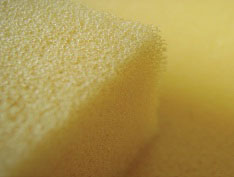Also, download this story from the electronic issue here
Flame retardants have been developed, and are added to plastic products, to protect consumers from the risks of fires, yet studies suggest that even the newer forms of flame retardants can pose risks to the health of children.
Increasing use of FRs
Flame retardants (FRs) are chemicals that prevent or delay the combustion of materials used in products we use practically every day. Television sets, computers, mobile devices, roofs and carpets, you name it, it has a flame retardant!
One may conclude therefore that FRs are increasingly becoming indispensable. Fire safety is the foremost reason that these chemicals are used, according to the North American Flame Retardant Alliance (NAFRA). It says that FRs “delay flashover (of fire) and reduce the rate and intensity of burning and increase the amount of time people have to escape.”
It is for this reason that the consumption of FRs is increasing across major sectors, such as construction, automotive, and electrical/electronics sectors. Market research institute Ceresana forecasts the FR market to reap revenues worth US$7.15 billion in 2021.
What is driving the increasing demand are the stricter fire-safety standards, new regulations, and the introduction of eco-labels that have encouraged industry commitment to comply with fire safety measures.
The most important application area for FRs is the construction sector, especially since there is already an increasing amount of flammable materials being used in thermal insulation and improvement of energy efficiency of residential buildings.
Since FRs are used in plastic products, pipes and cables made of plastics, are now replacing metal ones in modern building and housing construction.
Asia Pacific holds the largest sales market for FRs, with China accounting for nearly 24% of the global demand, according to Ceresana.
The US is the second largest market, owing to the increasing activities in the construction industry; while the Middle East and South America are found to be growth areas.
China, Asia’s biggest producer and market
In a new market study on China’s FR sector, GCiS China Strategic Research estimates that the domestic market in the country was valued nearly US$1.1 billion in 2014.
The China-based research firm says that the growth of the market will continue in the next few years, but the growth rate will vary by product type.
China will be a major global market growth driver in terms of production, domestic consumption, as well as direct exports. The country produces phosphorous FR chemical that is gradually replacing previously popular halogen-containing chemicals in a broad range of applications, particularly in the plastics and rubber segment. Consumption of inorganic FRs is also on the rise, driven by local and overseas FR standards and environmental regulations.
However, China’s weaker law enforcement and supervision may make the transition slower than suppliers’ optimistic expectations, says GCiS.
China is expected to remain the largest consumer, with 30% of global consumption in 2018, according to research firm IHS’s report for 2014. It says that the Chinese consumption for FRs, such as chlorinated compounds, organophosphorus compounds and aluminium trihydroxide (ATH), has risen.
Opportunities and challenges
The widespread use of petroleum-based materials and synthetic polymers also ups the ante for fire risks and hazards.
Thus, according to NAFRA, new opportunities for these special chemicals are presented by the changing standards for flame retardancy and fire safety as well as in applications for specific types of plastics.
Consultancy group IHS reports that “new polymerbased and synergistically acting flame retardant systems, especially in the electrical/electronic and insulation sectors, as well as the rising global demand for optical fibres in buildings, are also spurring opportunities.”
However, FRs are on an uphill climb. Another research firm Markets and Markets reveals that there is a shortage of the raw materials used in the production of FRs and increasing prices of raw materials also add up to the challenges.
Then, there are also toxicity issues being linked to FR use and production. There are already researches being conducted to support evidences of toxicity as well as safety of FRs.
Citing one such research, evidence gathered by researchers at the Environmental Working Group (EWG) and Duke University pointed out the impact of FRs, particularly the Tris (1-chloro-2-propyl) phosphate (TDCIPP) exposure to children. The EWG study found that the average level of a carcinogenic FR chemical in the bodies of children tested was almost five times the average in their mothers. The test conducted used urine analysis of the subjects, and found the presence of BDCIPP, a metabolite formed when TDCIPP breaks down in the body,
Further, these chemicals, which are found to be present even in the most ordinary household item and furniture, migrate and mingle with dust, thus contaminating and/or exposing users to the hazardous effects (mostly through inhalation or ingestion).

EWG says that the TDCIPP and other FRs are found in polyurethane foam used in furniture, automotive cushioning, baby bedding, and nursing pillows, to name a few.
Newer forms of FRs also a hazard
While the FRs being used in the research are already the newer class of retardants that are replacing the obsolete ones, particularly the polybrominated diphenyl ether (PBDE), which was banned in 2005 due to findings linking it to health risk to children and women, the risks are still evident.
Some of the newer and alterative compounds currently being used include chlorinated alkyl and non-chlorinated aryl organophosphate flame retardants (OPFRs) and aromatic brominated compounds.
In other words, the phase out has spurred the widespread use of the newer chemicals, which EWG suggests, are as harmful as PBDE.
Labelling needed to identify harmful FRs
In the US, the use of FRs in consumer and household items is to meet fire safety standards. However, for consumers, discerning which goods are FR-free is difficult, if not impossible.
According to the 2012 publication on FRs by the American Chemical Society, due to the lack of labeling requirements, to determine the presence or identification of the FRs in products one has to resort to the proprietary nature of some FRs.
Meanwhile, the Environmental Protection Agency (EPA) has begun reviewing 20 FRs used in common household items; as well as conducting risk assessments on four of the chemicals under the existing Toxic Substances Control Act, which might also need reforms, according to EPA.
In China, Asia’s hotbed for FRs, a study has been conducted in Nanjing University to examine the potential genotoxicity of dechlorane plus (DP), a chlorinated FR, which the study also mentions to be a “potentially persistent organic pollutant (POP) and an environmental toxin”. The research used luminous bacteria as testing organisms to determine the toxicity potentials.
The findings indicated that the comet assay on the organism showed a significant increase in DNA damage when the concentrations of DP were increased.
Thus, the EWG study recommends that governments worldwide ban FRs in products intended for babies and children, label furniture products and disclose the FR content, as well as reform policies to make way for toxicity testing of the chemicals.
Moreover, FR manufacturers are also showing commitment by investing heavily into R&D to produce biobased FR chemicals, according to the Markets and Markets report. It is hoped that these projects will see fruition to avoid toxic levels increasing in the next generation.
(PRA)
































